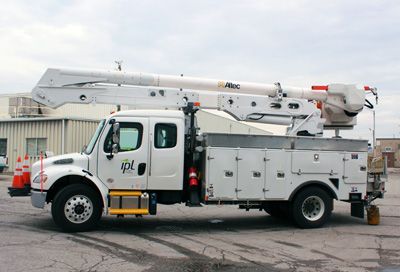
The State of Lightweight Materials for Utility Fleet Vehicles
High fuel prices 10 years ago were a big reason for the surge in sales of lightweight materials and components for utility vehicles. Although fuel prices have dropped significantly since then, lightweight alternatives to steel are still popular and have found a solid niche within the market.
“While lightweight components are often associated with fuel reductions and are a significant contributor to advances in reducing fuel burned, they have other equally important uses,” said George Survant, senior director of fleet relations for NTEA – The Association for the Work Truck Industry (www.ntea.com). “They can be used to increase discretionary payload on an existing chassis, help keep a truck under bridge law restrictions, extend effective body life and help keep medium-duty trucks under the federal excise tax (FET) weight ranges.”
For decades, aluminum has been the popular, albeit more expensive, lightweight option to steel, both inside and outside vehicles. Its weight advantage can total up to 50 percent savings compared with steel, according to F3 MFG Inc. (http://f3mfg.com), a Waterville, Maine-based upfitter specializing in aluminum bodies.
Aluminum bodies stand up well in certain applications, and aluminum’s corrosion-resistance property can make it a viable, maintenance-free replacement for steel.
“As lightweight body components are typically made from composites – like fiberglass and carbon fiber – or with aluminum materials, they offer an additional advantage to weight reduction by extending the useful life of the truck over traditional steel,” Survant said. “Corrosion in these components becomes a significantly reduced problem.” Nevertheless, Survant noted, it’s important to remember that the vehicle specification when using aluminum needs to address the issues arising from the mating of dissimilar materials.
Rick Mendez, fleet manager with Magic Valley Electric Cooperative in Mercedes, Texas, said the electric utility began spec’ing aluminum for shelving and bulkheads in its vans, not for its weight-saving properties but for its corrosion-resistant properties.
“We live next to the coast, and instead of galvanized steel we’re [using] aluminum,” Mendez explained. “That’s more for the atmosphere. We don’t want it to corrode or rust out, and aluminum holds up very well down here in the valley.”
Making Inroads
While aluminum is perhaps the most popular lightweight alternative to steel, other materials are making inroads in new areas.
In 2014, Indianapolis Power & Light Co. (IPL) began shifting to fiberglass from traditional steel beds on their larger trucks, including line trucks, digger derricks and even the smaller Class 5 Ford F-550s, said Brian Osborn, manager of fleet and facilities. “Primarily, the No. 1 reason was [to reduce] rust and decay. The vehicles are not housed in garages, they’re 100 percent in the weather all the time, and the fiberglass significantly cuts down on the degradation of the vehicles.”
By switching to fiberglass, IPL also was able to significantly increase vehicle payloads, which translated into increased efficiencies at job sites since crews are able to carry more parts, the company said.
The switch to fiberglass and the accompanying weight savings also mean less wear and tear on the axles, said Kim Garner, IPL fleet administrator.
“It was a big step to go with fiberglass. Our trucks have been rusting for many years here in Indiana. For the company to go with fiberglass is a huge accomplishment,” Garner said.
According to Survant, “Utility buyers are often building trucks right at the weight levels where FET comes into effect. The ability to add discretionary payload to a vehicle while staying under the FET minimum limits can save significant dollars in purchasing a truck.”
Recent advances in materials and production methods have helped other materials, such as ABS composites, establish their place as steel alternatives, especially in shelving, racks and partitions. Their light weight, durability, and corrosion-resistant and sound-deadening properties give fleets additional materials options.
About the Author: Jim Galligan has been covering the commercial truck transportation sector for more than 30 years and has extensive experience covering the utility fleet market. In addition to writing and editing for magazines, his background also includes writing for daily newspapers, trade associations and corporations.
*****
Aluminum’s Use in Vehicles Continues to Grow
Alternative materials to steel have been making inroads into the commercial vehicle market for years, and recent studies point toward continued growth in the automotive and light-truck sectors. While it’s difficult to drill down through broad industry-wide data to find the specific details within the commercial truck sector for cargo management products, the aluminum industry and aluminum component suppliers are bullish about its role as the primary alternative to steel in future vehicles and components.
By 2020, the average aluminum content in vehicles will range from 262 pounds in passenger cars to more than 550 pounds in the average pickup truck, according to a July 2017 study for The Aluminum Association (www.aluminum.org) conducted by Ducker Worldwide.
It still costs less to build a steel body, but aluminum proponents list a number of advantages aluminum has over steel, with weight savings and durability topping the list. The July 2017 Aluminum Association/Ducker Worldwide report noted that by 2025, the average vehicle would be 7 percent lighter than it was in 2015 due to the switch to more aluminum components and parts.


